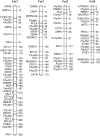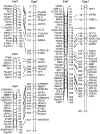A gene-based genetic linkage map of the collared flycatcher (Ficedula albicollis) reveals extensive synteny and gene-order conservation during 100 million years of avian evolution
- PMID: 18562642
- PMCID: PMC2475748
- DOI: 10.1534/genetics.108.088195
A gene-based genetic linkage map of the collared flycatcher (Ficedula albicollis) reveals extensive synteny and gene-order conservation during 100 million years of avian evolution
Abstract
By taking advantage of a recently developed reference marker set for avian genome analysis we have constructed a gene-based genetic map of the collared flycatcher, an important "ecological model" for studies of life-history evolution, sexual selection, speciation, and quantitative genetics. A pedigree of 322 birds from a natural population was genotyped for 384 single nucleotide polymorphisms (SNPs) from 170 protein-coding genes and 71 microsatellites. Altogether, 147 gene markers and 64 microsatellites form 33 linkage groups with a total genetic distance of 1787 cM. Male recombination rates are, on average, 22% higher than female rates (total distance 1982 vs. 1627 cM). The ability to anchor the collared flycatcher map with the chicken genome via the gene-based SNPs revealed an extraordinary degree of both synteny and gene-order conservation during avian evolution. The great majority of chicken chromosomes correspond to a single linkage group in collared flycatchers, with only a few cases of inter- and intrachromosomal rearrangements. The rate of chromosomal diversification, fissions/fusions, and inversions combined is thus considerably lower in birds (0.05/MY) than in mammals (0.6-2.0/MY). A dearth of repeat elements, known to promote chromosomal breakage, in avian genomes may contribute to their stability. The degree of genome stability is likely to have important consequences for general evolutionary patterns and may explain, for example, the comparatively slow rate by which genetic incompatibility among lineages of birds evolves.
Figures








References
-
- Åkesson, M., B. Hansson, D. Hasselquist and S. Bensch, 2007. Linkage mapping of AFLP markers in a wild population of great reed warblers: importance of heterozygosity and number of genotyped individuals. Mol. Ecol. 16 2189–2202. - PubMed
-
- Backström, N., S. Fagerberg and H. Ellegren, 2008. Genomics of natural bird populations: a gene-based set of reference markers evenly spread across the avian genome. Mol. Ecol. 17 964–980. - PubMed
-
- Beraldi, D., A. F. McRae, J. Gratten, J. Slate, P. M. Visscher et al., 2007. Mapping quantitative trait loci underlying fitness-related traits in a free-living sheep population. Evolution 61 1403–1416. - PubMed
Publication types
MeSH terms
Substances
LinkOut - more resources
Full Text Sources

